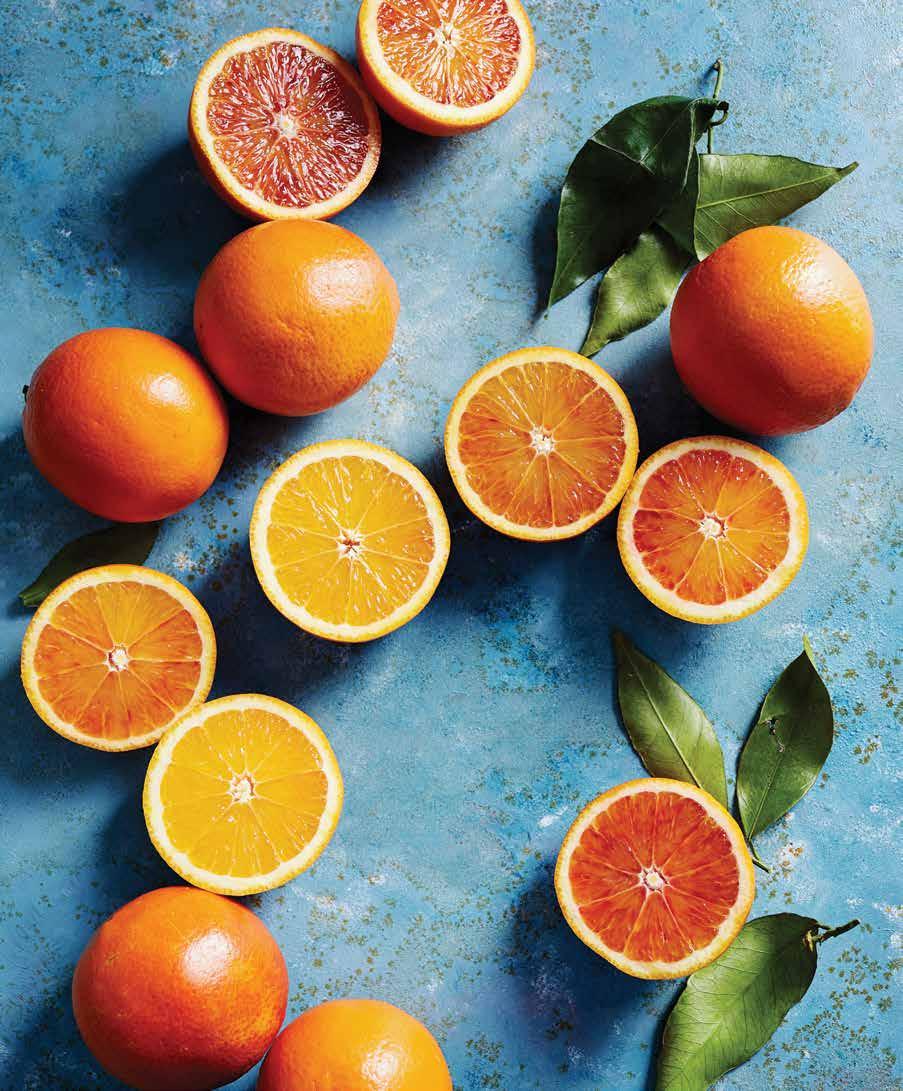
10 minute read
Squeeze the Day
So now we know where oranges originated and how they got to Florida, but let’s take a closer look at how they arrived in the Golden Isles. Shortly after the Spanish founded St. Augustine in 1565, they established missions in Georgia’s barrier islands, including on the south end of St. Simons. It is likely during this time that oranges trees were introduced on St. Simons Island, because Francis Moore described “a tall and thorny orange tree full of fruit” when he recorded the English arrival on St. Simons in his diary. When Fort Frederica was garrisoned, it became one of the most important towns in the colony. An account of the town at that time describes the streets as being “regularly laid out and margined with orange trees.” You can still see Seville orange trees bearing fruit on the grounds at Fort Frederica National Monument today.
Outside of Frederica, but in the nearby vicinity, colonists established farms and plantations on land they were granted. One of these early plantations was Orange Hall, General James Oglethorpe’s only home in America. It was recorded to be a small English style raised cottage surrounded by a grove of orange trees. Figs and grapes were also flourishing on his 50 acres of “perfect cultivation” in the midst of the Live oaks.
Cannon’s Point Scottish owner John Couper was one of the leading agriculturists in the world and a fantastically successful planter. Not only was Cannon’s Point a well-established cotton plantation, but its gardens were known for growing virtually every kind of flower, plant, and tree that could survive in our coastal environment. The property had groves of lemons and oranges, date palms imported from Persia, and olive trees imported from Marseilles at the suggestion of President Thomas Jefferson. Eventually the property fell into ruin and it is now a preserve under the protection of the St. Simons Land Trust.
There was also Orange Grove, south of Frederica on Dunbar Creek, which was property granted to John Terry, silversmith and recorder of Frederica. He “planted hundreds of orange trees and called his plantation Orange Grove.” After passing through ownership by several influential early island families, the Bruces, the Abbotts, and Fendigs, the historic tract became part of the property known as Sea Palms. Major Wright Road, Abbott Lane, and Terry Creek all were named to commemorate these Orange Grove inhabitants.
Fresh Picked, another gorgeous painting by Loren DiBenedetto from Anderson Fine Art Gallery, perfectly captures the ripe anticipation of peeling into a sweet and juicy orange picked right off the tree. This would add a lovely pop of color to your walls.



Unlike lemons and limes, sweet oranges are perfect to peel and eat just as they are. Navel oranges and other seedless varieties are generally preferred for this. If you’re squeezing for juice, Valencia oranges are a better choice. Some more exotic options are the sweet Cara Cara with its pinkish flesh, the distinctive red Blood Orange, and the large Sumo tangerine-orange hybrid. These three are excellent in salads. Sour Seville oranges are delicious in marmalade, and as flavoring in cocktails and salad dressings.
Sunny Spinach Salad
INGREDIENTS:
½ c. chopped walnuts 2 medium oranges 1 medium beet 8 oz. baby spinach 5 Tbsp. olive oil 2 Tbsp. balsamic vinegar ¼ tsp. salt, plus more to taste 1/8 tsp. freshly ground black pepper, plus more to taste 1/8 tsp sugar 3 oz. soft, mild goat cheese, crumbled ¼ c. red onions, sliced thin ½ c. dried cherries

ABOVE: For delicious fresh squeezed orange or grapefruit juice to start your day plus offerings like sausage gravy over fresh baked biscuits, pancakes, or Benedict Oscar, drop by Halyards for breakfast Wednesday-Sunday. If you’d like to “enhance” your juice, J.J. Mincey and the team would be happy to pour you a mimosa or this Grapefruit Mango Bellini made with Ruby Red grapefruit juice, mango purée, and champagne.
PREPARATION:
Preheat the oven to 350°F. Wash and dry beet, cut into wedges. Place beet wedges on tin foil and drizzle with olive oil. Wrap and bake in oven for 45 minutes or until tender. Spread walnuts on baking sheet and toast until fragrant and lightly colored, 5 to 6 minutes. Set aside until cooled slightly. Cut peels from oranges, leaving no white pith. Holding them over a small bowl, segment oranges, catching any juices. In a large bowl, combine the spinach and orange segments. In a small bowl, combine oil, vinegar, salt, pepper, sugar, and 2 Tbsp. of reserved orange juice. Whisk to combine. Taste, and adjust seasoning if necessary. Drizzle dressing over salad, tossing to coat it evenly. Add goat cheese, onions, beets, chopped walnuts, and dried cherries, and toss gently to combine. Season with salt and pepper, if desired, and serve immediately.
Orange Teriyaki Pork
INGREDIENTS
For sauce: 1 Tbsp. sesame oil 2 Tbsp. rice wine vinegar ¼ c. soy sauce 1 tsp. orange zest ¼ c. fresh squeezed orange juice 2 tsp. granulated sugar 1 tsp. light brown sugar, packed ¼ tsp. ground ginger 2 garlic cloves, pressed or finely minced
FOR PORK:
1 to 1¼ lbs. boneless pork tenderloin, cut crosswise into approx. 12 thin slices 1 Tbsp. sesame oil salt and pepper, to taste 1 Tbsp. sesame seeds, toasted 3-4 green onions, trimmed and cut diagonally on the bias into ¼” pieces orange slices for garnish
PREPARATION:
set aside. To a large skillet, add 1 tablespoon oil, pork slices, season with salt and pepper to taste, and cook over medium-high heat for about 2 to 3 minutes on each side or until done. Cook in batches if skillet can’t hold all the pork at once, adding additional oil if necessary. Remove cooked pork from skillet; set aside. Add sauce mixture to skillet and bring to a boil over medium heat. Cook for about 3 to 5 minutes or until mixture reduces slightly. Return pork to skillet and turn to coat with all sides. Evenly sprinkle with sesame seeds, top with green onions and orange slices, then serve.
When Life

gives you lemons
A Sip of Nostalgia
Agood many adults over age 30 have fond memories of a frosty, frothy orange drink known as the Orange Julius. According to pop culture lore, the birthplace of this cool, creamy drink was an orange juice stand, opened in Los Angeles in the mid-1920s by Julius Freed. As the tale goes, its name came from people in line for the citrus concoction shouting, “Give me an Orange, Julius!” Dairy Queen now has the corner on the market for this refreshing treat, and it’s not quite the same as the original version made with the intent of promoting fresh orange juice. Still, just the name can conjure images of sunny afternoons with friends and summer weekend fun. This may be a bit of a cheat, with frozen concentrate, but it tastes like Saturday at the mall.

Just Like a Julius
INGREDIENTS:
1 c. milk (2% or whole) 2 tsp. vanilla extract 6 oz. frozen orange juice concentrate ½ c. granulated sugar 1½ c. ice cubes
PREPARATION:
Pour milk, sugar, and vanilla in a blender and pulse until combined. Add frozen orange juice concentrate. Blend until fully combined. Add ice cubes and blend until ice is crushed and mixture is thick and frothy. (If mixture is too thick, add water one tablespoon at a time, mixing after each addition until it’s the desired consistency.) Pour into glasses and serve with a straw. Alternate variations: substitute frozen lemonade or 6-8 oz. of frozen pineapple or frozen strawberries for frozen orange juice.

Complete Dental
Care for Infants, Children and Teens.
– NO REFERRAL NECESSARY –
We take the time to attend to each child’s individual needs.
Certified, American Board of Pediatric Dentistry 2487 Demere Rd., Suite 300 St. Simons Island, GA 912-638-9302 WhatleyPediatricDentistry.com

When Life

gives you lemons Keep It Zesty

We’ve been touting all the ways to eat, drink, cook and bake with your oranges, lemons, and other citrus fruit, but here are some additional ways to use and preserve your fruit.
PRESERVE THE JUICE. You can juice citrus fruits and store in the fridge for up to two weeks or in the freezer for several months. If freezing, pour fresh-squeezed juice into ice cube trays and, once frozen, transfer to freezer bags. If refrigerating, use airtight bottles or jars. (You can freeze fruit whole to be thawed and juiced later too!)
DRY THE PEELS. Dried peels can be used in many ways, from making tea to bath and body products. Use organic citrus and wash well before use (same for zest). Whenever you peel your citrus fruit to use the flesh, save the peels by breaking them up into smaller pieces and drying them for later use.You can air dry the peels, use a dehydrator, or bake them on the lowest setting in your oven. Once dried, transfer peels to a jar or container and store in a cool, dark, dry place.

SAVE THE ZEST. Grate or thinly peel the outer layer of the peel of the citrus fruit with a fine grater, paring knife or a vegetable peeler, avoiding the bitter, white pith. Use the zest fresh or dry it to use later. To dry, spread in a thin layer over a baking tray and leave to air dry in an area with low humidity. Once dry, transfer to a jar or other small airtight container and store in a cool, dark place. It will keep for a long time, but will lose its potency after a few months. You can use dried zest for fresh zest in any recipe that calls for it or add it to homemade bathroom cleaner.
MAKE AN ALL-PURPOSE CITRUS
CLEANER. Take fresh citrus peels and put them in a quart-sized mason jar and completely cover with white vinegar. Let sit for six weeks, then strain the vinegar into a bottle and discard the peels. Store in a cool, dark place. Dilute with an equal amount of water and transfer to a spray bottle when ready to use. Use on countertops, floors, sinks, tubs and toilets and other hard surfaces. Do not use on marble as vinegar can stain it.
CANDY THE PEELS. Zest citrus peel into large chunks using a peeler or a pairing knife. Put one cup of peels into a pot and cover with water. Bring water to a boil and then reduce heat. Simmer for 10 minutes. Drain and repeat the process two more times. Heat ½ c. sugar with ¼ c. water until boiling. Add peel to sugar-water and let simmer for 15 minutes. Remove peels with a slotted spoon, dust with more sugar and let air dry on a baking sheet lined with parchment paper or dry in a dehydrator. Once completely dry, transfer to an airtight container and store in a cool, dry place for up to 3 months.
MAKE INFUSED CITRUS OIL. Citrus infused oil can be used to make body products or to add flavor to homemade salad dressings. To make, place dried citrus peels in a jar and cover with oil. Place in a cool, dark place and let sit for 4-6 weeks or longer. Strain and store in an airtight bottle.
FIRE IT UP! A few peels thrown in with fire kindling makes for an especially fragrant fire! This works best if peels are dried for a day or two beforehand. Collect the peels in a bowl and leave them out in the open or on top of a heater.









